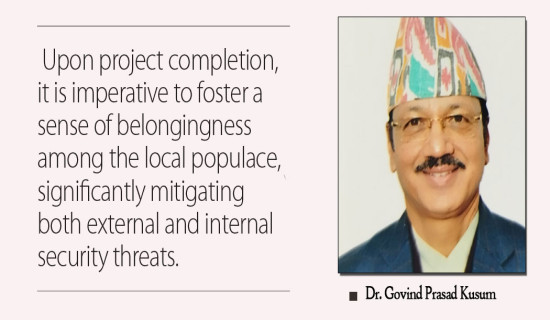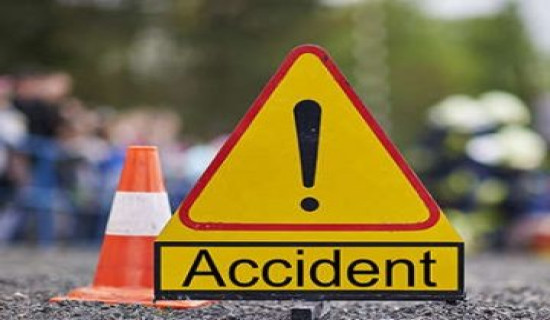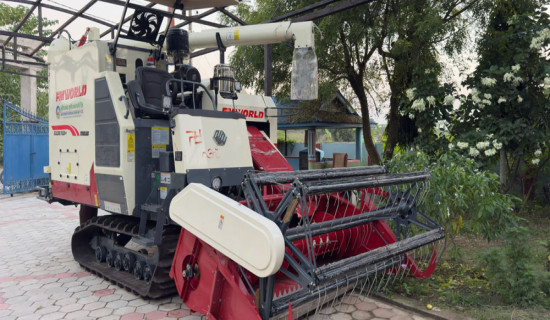- Saturday, 8 November 2025
Transport Sector In Need Of Revamp
Nepal is a landlocked country with difficult topography. So road construction is a difficult proposition. Although there are modes of land, water and air transport, the country has to rely on road and air transport. Being a landlocked country with no direct access to seas, the country is handicapped as far as water transport is concerned.
Ninety per cent of the population uses road networks for mobility and much of the freight is carried by road. The reason is obvious. Water transport is almost non-existent and air transport is costly. Air transport is limited to commercial and tourist destinations. Road transport consists mainly of vehicles, both public and private. Rail transport is also limited. There are two railway lines: the Jainagar-Janakpur railway and the Raxaul-Sirsiya railway.
There is talk about extending the railway network. China has announced a grant for conducting the feasibility study of the Kerung-Kathmandu-Lumbini railway. The construction of the East-West electric railway was started in the fiscal year 2009/10. And the works are going on but there is not much progress owing to factors such as the issue of compensation for land acquired for the project.
Jurisdiction
The road infrastructure in Nepal consists of the strategic road network (SRN) and the local road network (LRN). The SRN is looked after by the Department of Roads (DoR), whereas the LRN falls under the jurisdiction of the Department of Local Infrastructure Development and Agricultural Roads (DoLIDAR). The SRN includes national highways and feeder roads, whereas the LRN includes district, urban and rural roads. The LRN covers 82 per cent of the roads.
There was just 276 kilometres of road in 1956. Now, the length of road has increased to over 72,000 kilometres. During the early 1990s, there was remarkable development of roads in the rural areas. The Build Your Own Village campaign launched by the then government in 1994 had provision for a lump-sum grant of US$ 3,000 for each village development committee (VDC), which encouraged road building in the rural areas. However, the programme could not be sustained for long. Likewise, the Green Road concept that emerged in 1990 also played a catalytic role in expanding roads in the rural areas.
Nepal is committed to developing a sound transport system to achieve the Sustainable Development Goals by 2030. The benefits of a robust transport network are galore. In fact, transport is a stepping stone for initiating development works. If the transport sector is well-developed, other sectors can also be developed. The robust transport sector will increase people’s mobility, enhance access to healthcare facilities, facilitate access to markets, increase opportunities for education, increase income generation, reduce gender inequality, mitigate poverty and spur economic growth. It will also reduce road accidents and casualties. Further, a robust transport system reduces socio-economic imbalances by enhancing the access of common people to basic facilities such as healthcare, education and markets. The transport sector plays a pivotal role in socio-economic development.
Nepal is all set to introduce and scale up clean transport systems to manage burgeoning urbanisation and increase energy security to meet SDGs 7, 9 and 11. The process of incorporating SDGs into national policies and programmes began in 2014/15. There is a close relationship between a robust transport system and SDGs.
There is certainly progress in road development and expansion but the progress is not copacetic. Most of the roads are fair-weather, but not all-weather. When the rainy season sets in, such roads become muddy, making it unfit for vehicular movement. Such roads are found not only in the rural areas but in the urban areas, including in Kathmandu, too. Most of the roads are unpaved and even if paved, they are of poor quality, with the blacktop coming off in no time.
There are several factors contributing to the poor condition of roads. Contractors are selected mostly on the basis of political connections. Such contractors collect mobilisation amounts and delay completing road projects, resulting in cost overruns. The quality of the works of such contractors is often questionable. The monitoring process is weak. Although such contractors are sometimes penalised, it is not enough. They often go scot-free through a political nexus.
Maintenance of roads is of equal importance. After roads are constructed, they are not properly maintained from time to time. It is seen that some roads in bad condition are not repaired for years, whereas even good roads are blacktopped. This is a bad practice. Those people’s representatives who are influential can get a budget allocation and have the roads under their jurisdiction paved or repaired. The poor condition of roads can also be ascribed to lack of coordination among government entities such as Nepal Telecommunications Authority and Kathmandu Upatyaka Khanepani Limited (KUKL). Digging works continue all year round, disfiguring roads and increasing dust pollution.
Road congestion
The priority of the government should lie in paving dirt roads so that they can be converted into all-weather ones. There are many tourist junctions. But owing to the bad condition of roads, the country has not been able to take advantage of full tourism potential. Political leaders often talk of making Nepal a Singapore or a Japan but they never think about making cities and villages dust-free by improving the road infrastructure. There is congestion of roads in major cities owing to an ever-growing number of vehicles. What with dusty roads and what with a barrage of vehicles plying the roads, there is an increased level of air and dust pollution. To ease congestion of roads, the government should introduce a mass transit system. This will reduce the number of vehicles on the road.
After all, the transport sector is an artery of development. The government and the stakeholders concerned should work in tandem to improve the transport sector, which will also go a long way in achieving the SDGs as well.
(Maharjan has been regularly writing on contemporary issues for this daily since 2000. uttam.maharjan1964@gmail.com)

















